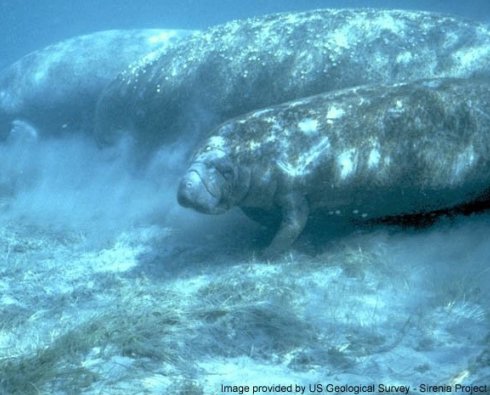- Sirenia
Taxobox
name = Sirenia
fossil_range = EarlyEocene - Recent

image_width = 200px
image_caption =West Indian Manatee s ("Trichechus manatus")
regnum =Animal ia
phylum = Chordata
classis =Mammal ia
infraclassis =Eutheria
superordo =Afrotheria
ordo = Sirenia
ordo_authority = Illiger,1811
subdivision_ranks = Families
subdivision =Dugong idae
Trichechidae
†Prorastomidae
†Protosirenidae :"Not to be confused with order
Sirenidae (aquatic salamanders)":"For the Gothic metal band, seeSirenia (band) "Sirenia is an order of fully aquatic, herbivorous mammals that inhabit rivers, estuaries, coastal marine waters, swamps, and marine wetlands. The order evolved during the Eocene epoch, more than 50 million years ago. Sirenians, including
manatee s and theDugong , have majoraquatic adaptation s: forelimbs have modified into arms used for steering, the tail has modified into a paddle used for propulsion, and the hind limbs (legs) are but two small remnant bones floating deep in the muscle. They appear fat, but arefusiform , hydrodynamic, and highly muscular. Their skulls are highly modified for taking breaths of air at the water's surface anddentition is greatly reduced. The skeletal bones of both the manatee and dugong are very dense which helps to neutralize the buoyancy of their blubber. The manatee appears to have an almost unlimited ability to produce new teeth as the anterior teeth wear down. They have only twoteat s, located under their forelimbs, similar toelephant s. Theelephant s are thought as the closest living relative of the sirenians.The three manatee species (family Trichechidae) and the Dugong (family Dugongidae) are endangered species. All four living species are vulnerable to extinction from habitat loss and other negative impacts related to human population growth and coastal development. Already the
Steller's Sea Cow has been hunted into extinction by humans. Manatees and the Dugong are the only marine mammals classified asherbivore s. Unlike the other marine mammals (dolphin s,whale s, seals,sea lion s,sea otter s, andwalrus es), sirenians eat primarily sea-grasses and other aquatic vegetation and have an extremely lowmetabolism and poor tolerance for especially cold water. Sirenians have been observed eating dead animals (sea gulls), but their diet is made up primarily of vegetation. Like dolphins and whales, manatees and the Dugong are totally aquatic mammals that never leave the water — not even to give birth. These animals have been observed eating grass clippings from homes adjacent to water ways, but in this rare occurrence, only the top portion of the sirenia is lifted out of the water. The combination of these factors means that sirenians are restricted to warm shallow coastal waters, estuaries, and rivers, with healthyecosystem s that support large amounts of seagrass and/or other vegetation.The Trichechidae species differ from Dugongidae in the shape of the skull and the shape of the tail.
* ORDER SIRENIA
** Genus †"Ishatherium "
*** †"Ishatherium subathuensis"
** Family †Prorastomidae
*** Genus †"Pezosiren "
**** †"Pezosiren portelli "
*** Genus †"Prorastomus "
**** †"Prorastomus sirenoides "
** Family †Protosirenidae
*** Genus †Protosiren
**** †"Protosiren minima "
**** †"Protosiren sattaensis "
**** †"Protosiren fraasi "
**** †"Protosiren smithae "
** FamilyDugong idae
*** Genus †"Sirenotherium "
**** †"Sirenotherium pirabense "
*** SubfamilyDugong inae
**** Genus "Dugong "
*****Dugong , "Dugong dugon"
*** SubfamilyHydrodamalinae
**** Genus †"Dusisiren "
***** †"Dusisiren dewana "
***** †"Dusisiren jordani "
***** †"Dusisiren takasatensis "
**** Genus †"Hydrodamalis "
***** †"Hydrodamalis cuestae "
*****Steller's Sea Cow , †"Hydrodamalis gigas"
** FamilyTrichechidae
*** Genus "Trichechus
****West Indian Manatee , "Trichechus manatus"
*****Antillean Manatee , "Trichechus manatus manatus"
*****Florida Manatee , "Trichechus manatus latirostris"
****African Manatee , "Trichechus senegalensis"
****Amazonian Manatee , "Trichechus inunguis"
****Dwarf Manatee , "Trichechus bernhardi" (validity questionable)† extinctSee also
*
Evolution of sirenians References
*MSW3 Shoshani|pages=92-93
* Garrison, Tom - Oceanography 5th Edition
* [http://www.paleodb.org The Paleobiology Database]External links
*http://www.sirenian.org/ Sirenian International - Manatee & Dugong Research, Education, & Conservation
* [http://www.hans-rothauscher.de/dugong/4legs.htm The earliest known Sirenian is "Pezosiren portelli"] .
*http://www.savethemanatee.org/ Save The Manatee - Help protect this endangered species.
Wikimedia Foundation. 2010.
